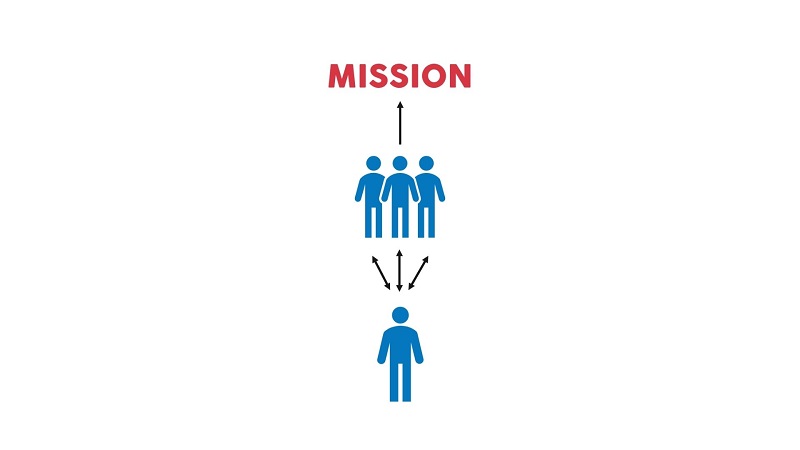The ‘People’ Factor: Why Relationships Matter in Leadership 2/1/2022
.jpg)
It’s called the “leadership dance.”
That’s when members of a high-performing team seamlessly shift leadership responsibilities back-and-forth depending on the task and each member’s particular skill set. One member who is good at writing may take the lead on a blog post, while another with more financial skills may budget out an expense. Still another who is very diplomatic may be the one who reaches out to an irate customer about a touchy service issue.
And the only way this happens is when both the leader and the team have a strong relationship that is based on trust. They know each other at a deep level, are intimately familiar with each other’s strengths, weaknesses, motivations and passions, so that each knows what will bring out the best in each other in support of the team’s overall mission (see the Billions example in the sidebar).
“Our core definition of leadership is who you are and what you do to influence others to act in alignment with the mission,” says Sean Georges, who, along with John Buford, PhD, are Co-Authors of the book, “On Mission: Your Journey to Authentic Leadership,” (due out in July) and Co-Founders of consulting firm On Mission Leadership. “We influence each other most powerfully and most significantly through our relationships with one another.”
What’s more, we can only influence another person if they permit us to influence them. Sure, you can make a team member do something by virtue of your authority, or by the promise of reward or punishment alone, but what results is mere compliance, if not an undermining of that authority. To really get the most from the team members, they have to want to do it.
Getting to know the team
Building such strong relationships requires getting to know your team on a deep level. This requires a strong sense of empathy and an understanding of what they value, what they believe about the world around them, why they are with you, and what motivates them.
And while an afternoon at TopGolf is a great start, there are no real short cuts. “It’s really through shared hardships and successes over time that these relationships develop,” says Buford. “And the only way you can build this trust is by being trustworthy, showing your team that you are there to serve them.”
Not surprisingly, listening is important. Level three listening, to be exact. In the book, the Georges and Buford discuss three different levels of listening. In Level 1 listening, you are basically just waiting for your turn to speak, giving all of the expected non-verbal cues, like nodding your head, saying “uh-huh,” etc. Level 2 listening is hearing what they are saying, but not trying to understand.
Level 3 listening, however, is trying to understand the messenger behind the message. “Listening with empathy is and trying to really understand the feelings behind the speaker’s emotions and is a critical skill for a leader to have,” says Buford.
Letting the team get to know you
Building relationships is a two-sided coin; just as it’s important for leaders to get to know their teams, the reverse is also true. The leaders should “let the team inside,” so to speak, and give them some insight into what makes them tick.
“Authentic relationships require that both parties know each other at a certain level,” says Georges. “Leaders have a responsibility to show their humanity to those they intend to influence. They need to be clear about their strengths and experiences, the skill sets they bring to the team, but also where their skills may be lacking and where they may need assistance.”
The same goes for which behaviors they will tolerate and which they will not. How much risk is permissible? Is it okay to “fail forward” and learn from the experience? Leaders must make themselves clear on these points so that expectations are set. And when it comes to behavior-setting, nothing is better than leading by example.
Leading with LOVE
Perhaps the most important component of building strong relationships with the team is love, and when Georges and Buford say love, they refer to the Greek word, agape (pronounced, ahh-gah-pay), which means one’s unselfish love for others.
“You cannot lead without love, nor can you serve effectively without love,” says Georges. “What is required to authentically serve another human being is a sense of love. Many of us have been trained or conditioned to keep people at a distance. You can keep a healthy distance yet still love. And you can’t fake this. When you lead, you accept the personal responsibility to serve others, which moves you to give and invest in them without expecting or demanding anything in return.”
In the book, the authors list out several common traits they found among authentic leaders they have served in the past, and while these leaders may have never said the word, “love,” their actions made love’s presence clear. These traits were:
- Patience
- Kindness
- Not envious
- Never boastful
- Not proud
- Do not dishonor others
- Not self-seeking
- Not easily angered
- Keep no record of wrongs
- Do not delight in evil
- Rejoice with the truth
- Protect
- Trust
- Hope
- Persevere
In addition, they didn’t shy away from pointing out honest mistakes, and held their teams accountable in constructive ways for their decisions, behavior and performance. While this may have stung at times, they did it in ways that were elevating rather than soul-crushing.
Relationships take time
As we alluded to earlier, there is no magic bullet to make these relationships happen overnight. They take time and effort – lots of time and effort, in some cases, depending on the individual personalities of the staff. “I’m an introvert, and it takes people a while to get to know me,” says Buford. “I’d like to think that once they do know me, it works well, but it does take longer. Some people are an open book and you get to know them fairly easily. But by asking deep questions, and through shared experiences, shared successes and failures, we really get to understand each other.”
So if you are looking to build a high-performing team, make some time to get to know them beyond just what they can do for you and the organization. In the long run, both you and the organization will benefit from the effort!
Learn more about Sean Georges and John Buford at their website: On Mission Leadership
Click here to pre-order "On Mission: Your Journey to Authentic Leadership"!
Knowing what moves the squad: An example from Showtime's 'Billions'
In the first episode of the latest season of the Showtime hit series, "Billions" (my favorite show), COO Michael Wagner demonstrates that he knows what "moves the squad" when he gives his company's new owner the lowdown on the team:
"Victor acts like a capo in the sixth mob family but translates French literature in his spare time, and he has taken a personal vow never to have a down quarter because that's how he proves to his dead father he is the better man.
"Ben Kim got a perfect score on his SATs but he feels like he is the dumb one in his family. His mother's alive but she already haunts him. That nice guy thing is cloaking a giant ambition that needs to be unleashed.
"Tuk tried to date the prettiest girl in his high school but she crushed him, told him he was a loser. He is desperately afraid that he's right and he won't stop until he is rich as Gatsby to prove her wrong.
"And Bonnie. She's tribal. She hates outsiders, and considers basically everyone an outsider. But once you are in, you'll see that inside of the pistachio-shell exterior she's got a giant heart and will protect you like a momma badger. And she's terrified of being alone, which can be marshalled into making her an earner of the first order."
CLICK HERE TO LISTEN TO THE AUDIO IN PODCAST FORMAT

